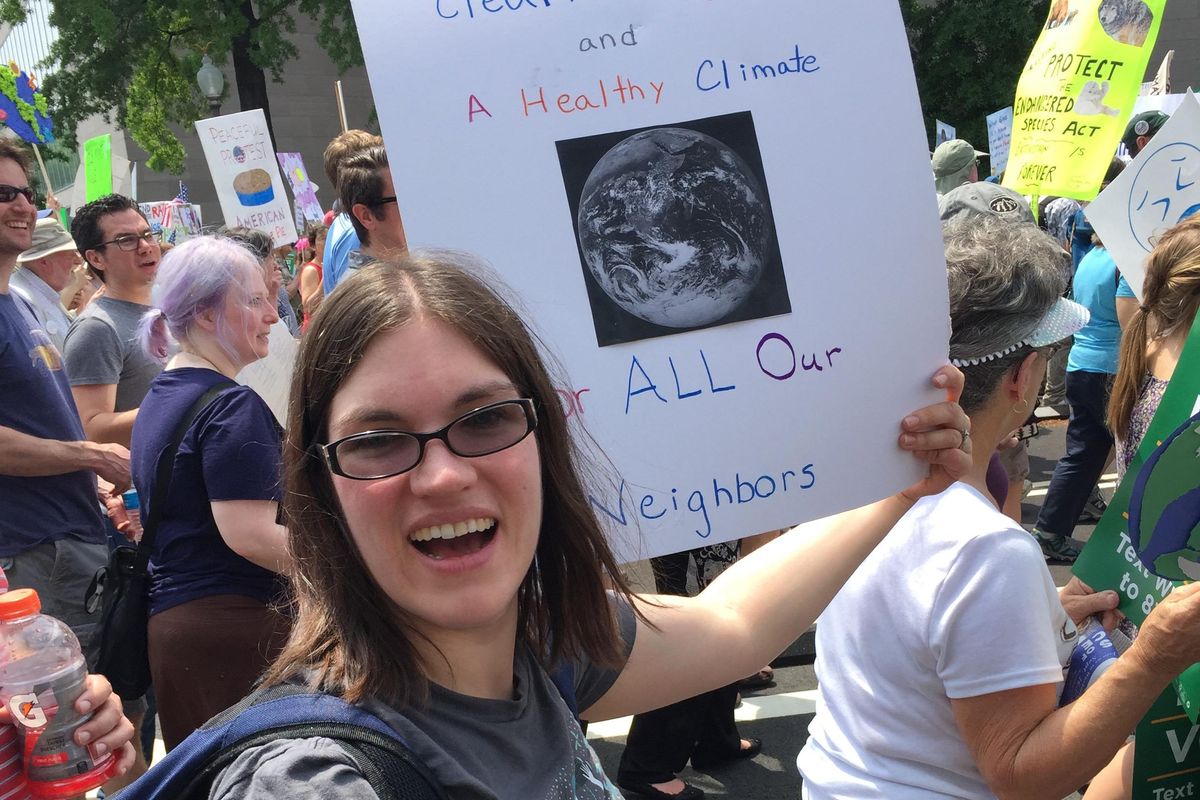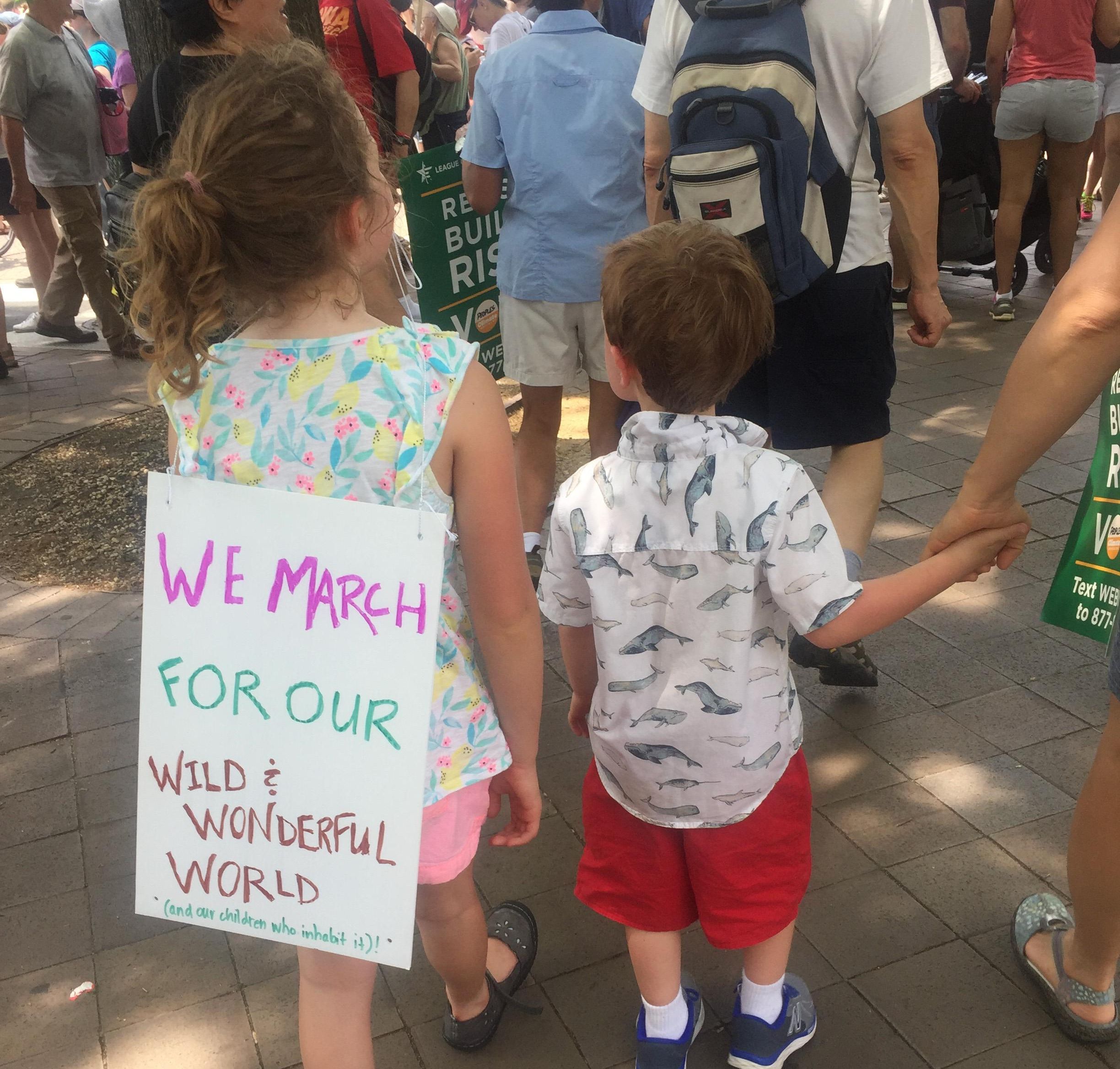Climate change impacts us all. Here's how sustainable family habits can help us all fight it.

Shannon Brescher Shea and family at rally.
If you grew up in the late '80s or early '90s you probably remember all the talk of the ozone layer deteriorating. We traded our Aqua Net cans for the pump hair spray that often left our hair more damp and floppy, than the beautifully coifed waterfall bang teased to the heavens that we were actually going for. We yelled at our parents for not cutting up their plastic six-pack rings because of the sea turtles and their survival. Suddenly, news of the environment and earth's impending doom was constantly on the news and sneaked into our television shows on Nickelodeon and commercials on MTV. We heard about oil spills and animal extinction, and we were rightfully cautious and outraged.
Today, we still cut our plastic rings before discarding them and opt for the pump sprayer over the aerosol can. We didn’t know then that we were young activists, we only knew we wanted to be good stewards of the planet we inhabited and we were going to drag our parents along with us. The fight for climate change and maintaining a healthy Earth didn’t end in the '90s. It’s something people are now more intentional about and are working to raise their children in a way that helps to prolong the life of the planet we call home. That’s why I connected with climate activist Shannon Brescher Shea, author of Growing Sustainable Together: Practical resources for raising kind, engaged and resilient children.
I wanted to know what brought Shannon into climate activism, and how people can involve their children in making a lasting impact on the earth. Shannon was full of insights and ways parents can make small changes to their daily lives and ways they can get involved on a larger scale, joining a growing number of climate and sustainability activists.
Shannon said her activist origin story started in the summer of third grade where she learned about manatees and how they became endangered due to being hit by boats. This prompted her to talk with her class about adopting a manatee. “That was my first, very specific thing I remember falling in love with, and then also wanting to take action at the same time.” After adopting a manatee in third grade, Shannon fell in love with nature and animals, and as she got older, she says, “I came to understand the human impact and how humans and nature are not separate things. What humans do affects nature, but also it affects everybody else too.”

Shannon Brescher Shea at a rally.
Incorporating the passion she developed as a child into her own parenting and current climate activism is what prompted Shannon to write a parenting book on sustainability. When talking about the importance of incorporating the changes in her book with your own family, the climate activist says, “If we fully embrace these, yes, they can be big changes in our lives and sometimes changes that are kind of radical, but they can also lead to much better quality of life and have it help us have more fulfilled, healthy, and not just physically healthy, but emotionally and mentally healthy parts of life.”
Shannon talks about some children experiencing climate anxiety, which she describes as “this feeling that like climate change is happening and there's nothing I can do. And the adults are old school. And they betrayed us. They've handed us this future that we can't do anything about.” According to Shannon, there is something we can do about it and it’s something the whole family can be involved in. She says small changes can make a big difference, such as choosing to bike to school or using public transportation to get to work, which reduces your contribution to pollution and also encourages other people to consider following suit.

Kids at climate rally.
The important thing to remember, says Shannon, is to not stop at the small things. Composting is a great way to produce less waste, but getting involved in local cleanups of streams and advocating for bicycle lanes are tangible things you can do with your family that make a difference for the environment and the community as a whole. Involve children in climate activism, she says, and “just keep kind of expanding these conversations outward and outward, using very practical, concrete experiences that the kids are having, you can have that much more of an impact and help them think about how you have that ripple effect. Not to cause guilt or to shame, but to show how we're all connected and how things we do affect other people.”
Climate change continues to occur, and living a sustainable lifestyle can help combat some of the effects humans have on the climate. More and more young people are joining the fight against climate change and families like Shannon’s are helping to make a difference. If you’re unsure on where to start with living a sustainable lifestyle with your family, you can grab Shannon’s book, Growing Sustainable Together, for ideas on how to get started.
- Greta Thunberg powerfully calls out Congress for inaction on climate ... ›
- LA's new wildlife bridge will be the world's largest - Upworthy ›
- How you can help save the planet using the KonMari method this ... ›
- Red states make up half of the Top 10 states for clean energy - Upworthy ›
- Pacifico and Quiksilver have teamed up to provide a sustainable merch collection and clean beaches - Upworthy ›
- Scientists think space bubbles could save the planet - Upworthy ›
- Ozone layer makes significant progress against damage - Upworthy ›
- Ozone layer makes significant progress against damage - Upworthy ›
- 'The Goldilocks Mission' wants to teach climate change with TV - Upworthy ›
- Patagonian bartender takes sustainability to the next level - Upworthy ›
- Is AI ruining climate change progress? Experts think so. - Upworthy ›
- 2 years before ChatGPT, a kids cartoon warned us about the environmental impacts of AI - Upworthy ›
- What will Earth look like if all its land ice melts? These maps show the clear answer. - Upworthy ›
- The biggest proof of our climate catastrophe ever caught on film - Upworthy ›
- A student accidentally created a rechargeable battery that she says could last 400 years - Upworthy ›

